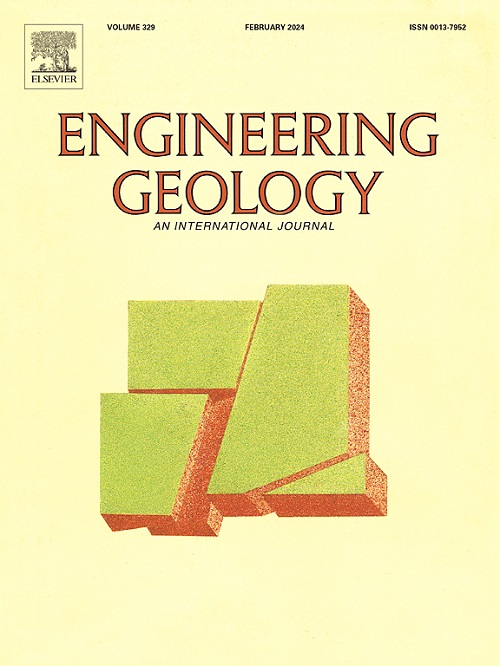Time-series InSAR landslide three-dimensional deformation prediction method considering meteorological time-delay effects
IF 6.9
1区 工程技术
Q1 ENGINEERING, GEOLOGICAL
引用次数: 0
Abstract
Landslide deformation prediction is a critical component of disaster early warning systems and significantly contributes to disaster prevention and mitigation. However, the high cost of traditional deformation monitoring equipment limits its extensive application across large areas. Furthermore, existing landslide deformation prediction methods often overlook the nonlinear influence of meteorological conditions. This study introduces a novel framework for predicting three-dimensional landslide deformations by employing time-series interferometric synthetic aperture radar (InSAR), which accounts for the time-delay effects of meteorological factors. First, the framework leverages ascending and descending orbit time-series InSAR technology to generate three-dimensional deformation data for landslides. Subsequently, the deformation data were decomposed into trend and periodic components using the complete ensemble empirical mode decomposition with adaptive noise (CEEMDAN) method. An autoregressive integrated moving average (ARIMA) model was developed for trend prediction, and an improved unscented Kalman filtering (UKF) model was developed for the periodic component. The prediction of the periodic component uses a second-order Taylor series and adaptive adjustments of observation and process noise covariance matrices to create a UKF deformation prediction model that incorporates meteorological time-delay effects. The method's effectiveness was validated through experiments on the Xiongba and Sela landslides in Gongjue County, Tibet. Results demonstrated that ascending and descending orbit time-series InSAR technology can accurately detect three-dimensional deformation, revealing maximum deformation rates of 43.81 cm/year for the Xiongba landslide and 31.83 cm/year for the Sela landslide. For the trend component, the ARIMA model achieved a correlation coefficient (R2) exceeding 0.9 and root mean square error (RMSE) below 1.0 cm across multiple monitoring points. Regarding the periodic component, the framework's reliability was first confirmed through simulation experiments. Further analyses of the Xiongba and Sela landslides revealed that rainfall and temperature exhibit distinct time-delay effects on deformation. Incorporating meteorological data into the improved UKF model significantly enhanced the prediction accuracy, yielding R2 values between 0.8 and 0.9, with the RMSE and mean square error (MAE) outperforming those of the long short-term memory (LSTM) and recurrent neural network (RNN) comparison models. Overall, the proposed framework offers vital technical support for risk prediction and early warning of large-scale landslide disasters, facilitating more accurate landslide forecasting.
考虑气象时滞影响的InSAR滑坡三维变形时间序列预测方法
滑坡变形预测是灾害预警系统的重要组成部分,对防灾减灾具有重要意义。然而,传统变形监测设备的高成本限制了其在大范围内的广泛应用。此外,现有的滑坡变形预测方法往往忽略了气象条件的非线性影响。本文提出了一种利用时间序列干涉合成孔径雷达(InSAR)预测三维滑坡变形的新框架,该框架考虑了气象因素的时滞效应。首先,该框架利用上升和下降轨道时间序列InSAR技术生成滑坡的三维变形数据。随后,采用自适应噪声全系综经验模态分解(CEEMDAN)方法将变形数据分解为趋势分量和周期分量。采用自回归积分移动平均(ARIMA)模型进行趋势预测,采用改进的无气味卡尔曼滤波(UKF)模型进行周期分量预测。周期分量的预测使用二阶泰勒级数和观测和过程噪声协方差矩阵的自适应调整来创建包含气象时滞效应的UKF变形预测模型。通过对贡觉县雄坝和色拉滑坡的试验,验证了该方法的有效性。结果表明,升降轨道时间序列InSAR技术可以准确探测三维变形,雄坝滑坡的最大变形速率为43.81 cm/年,Sela滑坡的最大变形速率为31.83 cm/年。对于趋势分量,ARIMA模型在多个监测点上的相关系数(R2)超过0.9,均方根误差(RMSE)低于1.0 cm。对于周期分量,首先通过仿真实验验证了框架的可靠性。对雄坝和塞拉滑坡的进一步分析表明,降雨和温度对变形具有明显的时滞效应。将气象数据纳入改进的UKF模型显著提高了预测精度,R2值在0.8 ~ 0.9之间,RMSE和均方误差(MAE)优于长短期记忆(LSTM)和循环神经网络(RNN)比较模型。总体而言,该框架为大规模滑坡灾害的风险预测和预警提供了重要的技术支持,有助于提高滑坡预测的准确性。
本文章由计算机程序翻译,如有差异,请以英文原文为准。
求助全文
约1分钟内获得全文
求助全文
来源期刊

Engineering Geology
地学-地球科学综合
CiteScore
13.70
自引率
12.20%
发文量
327
审稿时长
5.6 months
期刊介绍:
Engineering Geology, an international interdisciplinary journal, serves as a bridge between earth sciences and engineering, focusing on geological and geotechnical engineering. It welcomes studies with relevance to engineering, environmental concerns, and safety, catering to engineering geologists with backgrounds in geology or civil/mining engineering. Topics include applied geomorphology, structural geology, geophysics, geochemistry, environmental geology, hydrogeology, land use planning, natural hazards, remote sensing, soil and rock mechanics, and applied geotechnical engineering. The journal provides a platform for research at the intersection of geology and engineering disciplines.
 求助内容:
求助内容: 应助结果提醒方式:
应助结果提醒方式:


